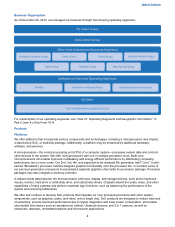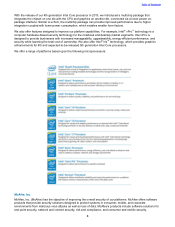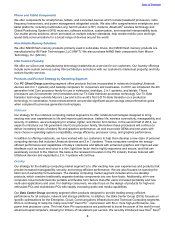Intel 2013 Annual Report Download - page 19
Download and view the complete annual report
Please find page 19 of the 2013 Intel annual report below. You can navigate through the pages in the report by either clicking on the pages listed below, or by using the keyword search tool below to find specific information within the annual report.
14
Intellectual Property Rights and Licensing
Intel owns significant intellectual property (IP) around the world that relates to our products, services, research and
development, and other activities and assets. Our IP portfolio includes patents, copyrights, trade secrets,
trademarks, trade dress rights, and maskwork rights. We actively seek to protect our global IP rights and to deter
unauthorized use of our IP and other assets. Such efforts can be difficult, however, particularly in countries that
provide less protection to IP rights and in the absence of harmonized international IP standards. See “Risk Factors”
in Part I, Item 1A, and “Note 26: Contingencies” in Part II, Item 8 of this Form 10-K.
We have obtained patents in the U.S. and other countries. While our patents are an important element of our
success, our business as a whole is not significantly dependent on any one patent. Because of the fast pace of
innovation and product development, and the comparative pace of governments’ patenting processes, our products
are often obsolete before the patents related to them expire; in some cases, our products may be obsolete before
the patents related to them are granted. As we expand our products into new industries, we also seek to extend our
patent development efforts to patent such products. In addition to developing patents based on our own research
and development efforts, we purchase patents from third parties to supplement our patent portfolio. Established
competitors in existing and new industries, as well as companies that purchase and enforce patents and other IP,
may already have patents covering similar products. There is no assurance that we will be able to obtain patents
covering our own products, or that we will be able to obtain licenses from other companies on favorable terms or at
all.
The software that we distribute, including software embedded in our component-level and platform products, is
entitled to copyright and other IP protection. To distinguish our products from our competitors’ products, we have
obtained trademarks and trade names for our products, and we maintain cooperative advertising programs with
customers to promote our brands and to identify products containing genuine Intel components. We also protect
details about our processes, products, and strategies as trade secrets, keeping confidential the information that we
believe provides us with a competitive advantage.
Compliance with Environmental, Health, and Safety Regulations
Our compliance efforts focus on monitoring regulatory and resource trends and setting company-wide performance
targets for key resources and emissions. These targets address several parameters, including product design;
chemical, energy, and water use; waste recycling; the source of certain minerals used in our products; climate
change; and emissions.
As a company, we focus on reducing natural resource use, the solid and chemical waste by-products of our
manufacturing processes, and the environmental impact of our products. We currently use a variety of materials in
our manufacturing process that have the potential to adversely impact the environment and are subject to a variety
of EHS laws and regulations. Over the past several years, we have significantly reduced the use of lead and
halogenated flame retardants in our products and manufacturing processes.
We work with the U.S. Environmental Protection Agency (EPA), non-governmental organizations (NGOs), OEMs,
and retailers to help manage e-waste (including electronic products nearing the end of their useful lives) and to
promote recycling. The European Union requires producers of certain electrical and electronic equipment to develop
programs that let consumers return products for recycling. Many states in the U.S. have similar e-waste take-back
laws. Although these laws are typically targeted at the end electronic product and not the component products that
we manufacture, the inconsistency of many e-waste take-back laws and the lack of local e-waste management
options in many areas pose a challenge for our compliance efforts.
We are an industry leader in our efforts to build ethical sourcing of minerals for our products, including “conflict
minerals” from the Democratic Republic of the Congo (DRC) and adjoining countries. In 2013, we accomplished our
goal to manufacture microprocessors that are DRC conflict free for tantalum, tin, tungsten, and gold. In 2014, we
will continue our work to establish DRC conflict free supply chains for these minerals for our company and our
industry.
Table of Contents
























